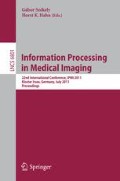Abstract
Entangled tree-like vascular systems are commonly found in the body (e.g., in the peripheries and lungs). Separation of these systems in medical images may be formulated as a graph partitioning problem given an imperfect segmentation and specification of the tree roots. In this work, we show that the ubiquitous Ising-model approaches (e.g., Graph Cuts, Random Walker) are not appropriate for tackling this problem and propose a novel method based on recursive minimal paths for doing so. To motivate our method, we focus on the intertwined portal and hepatic venous systems in the liver. Separation of these systems is critical for liver intervention planning, in particular when resection is involved. We apply our method to 34 clinical datasets, each containing well over a hundred vessel branches, demonstrating its effectiveness.
Access this chapter
Tax calculation will be finalised at checkout
Purchases are for personal use only
Preview
Unable to display preview. Download preview PDF.
References
Bauer, C., Pock, T., Sorantin, E., Bischof, H., Beichel, R.: Segmentation of Interwoven 3D Tubular Tree Structures Utilizing Shape Priors and Graph Cuts. Medical Image Analysis 14(2), 172–184 (2009)
Boykov, Y., Kolmogorov, V.: An Experimental Comparison of Min-Cut/Max-Flow Algorithms for Energy Minimization in Vision. IEEE Transactions on Pattern Analysis and Machine Intelligence 26(9), 1124–1137 (2004)
Couinaud, C.: Le Foie - Etudes anatomiques et chirurgicales. Masson (1957)
Fishman, E.K., Kuszyk, B.S., Heath, D.G., Gao, L.: Surgical Planning for Liver Resection. Computer 29(1), 64–72 (1996)
Glombitza, G., Lamadé, W., Demiris, A.M., Göpfert, M.R., Mayer, A., Bahner, M.L., Meinzer, H.P., Richter, G., Lehnert, T., Herfarth, C.: Virtual Planning of Liver Resections: Image Processing, Visualization and Volumetric Evaluation. International Journal of Medical Informatics 53(2-3), 225–237 (1999)
Grady, L.: Random Walks for Image Segmentation. IEEE Transactions on Pattern Analysis and Machine Intelligence 28(11), 1768–1783 (2006)
Gray, H.: Anatomy of the Human Body. Lea & Febiger, 1918, Philadelphia (2000)
Kaftan, J.N., Tek, H., Aach, T.: A Two-Stage Approach for Fully Automatic Segmentation of Venous Vascular Structures in Liver CT Images. In: SPIE Medical Imaging, vol. 7259, pp. 725911–1–12 (2009)
Kiraly, A.P., Helferty, J.P., Hoffman, E.A., McLennan, G., Higgins, W.E.: Three-Dimensional Path Planning for Virtual Bronchoscopy. IEEE Transactions on Medical Imaging 23(11), 1365–1379 (2004)
Low, G., Wiebe, E., Walji, A.H., Bigam, D.L.: Imaging Evaluation of Potential Donors in Living-donor Liver Transplantation. Clinical Radiology 63(2), 136–145 (2008)
Park, S., Bajaj, C., Gladish, G.: Artery-Vein Separation of Human Vasculature from 3D Thoracic CT Angio Scans. In: Computational Modeling of Objects Presented in Images: Fundamentals, Methods, and Applications (CompIMAGE), pp. 23–30 (2006)
Saha, P.K., Gao, Z., Alford, S.K., Sonka, M., Hoffman, E.A.: Topomorphologic Separation of Fused Isointensity Objects via Multiscale Opening: Separating Arteries and Veins in 3-D Pulmonary CT. IEEE Transactions on Medical Imaging 29(3), 840–851 (2010)
Selle, D., Preim, B., Schenk, A., Peitgen, H.-O.: Analysis of Vasculature for Liver Surgical Planning. IEEE Transactions on Medical Imaging 21(11), 1344–1357 (2002)
Soler, L., Delingette, H., Malandain, G., Montagnat, J., Ayache, N., Koehl, C., Dourthe, O., Malassagne, B., Smith, M., Mutter, D., Marescaux, J.: Fully Automatic Anatomical, Pathological, and Functional Segmentation from CT Scans for Hepatic Surgery. Computer Aided Surgery 6(3), 131–142 (2001)
Author information
Authors and Affiliations
Editor information
Editors and Affiliations
Rights and permissions
Copyright information
© 2011 Springer-Verlag Berlin Heidelberg
About this paper
Cite this paper
O’Donnell, T., Kaftan, J.N., Schuh, A., Tietjen, C., Soza, G., Aach, T. (2011). Venous Tree Separation in the Liver: Graph Partitioning Using a Non-ising Model. In: Székely, G., Hahn, H.K. (eds) Information Processing in Medical Imaging. IPMI 2011. Lecture Notes in Computer Science, vol 6801. Springer, Berlin, Heidelberg. https://doi.org/10.1007/978-3-642-22092-0_17
Download citation
DOI: https://doi.org/10.1007/978-3-642-22092-0_17
Publisher Name: Springer, Berlin, Heidelberg
Print ISBN: 978-3-642-22091-3
Online ISBN: 978-3-642-22092-0
eBook Packages: Computer ScienceComputer Science (R0)

